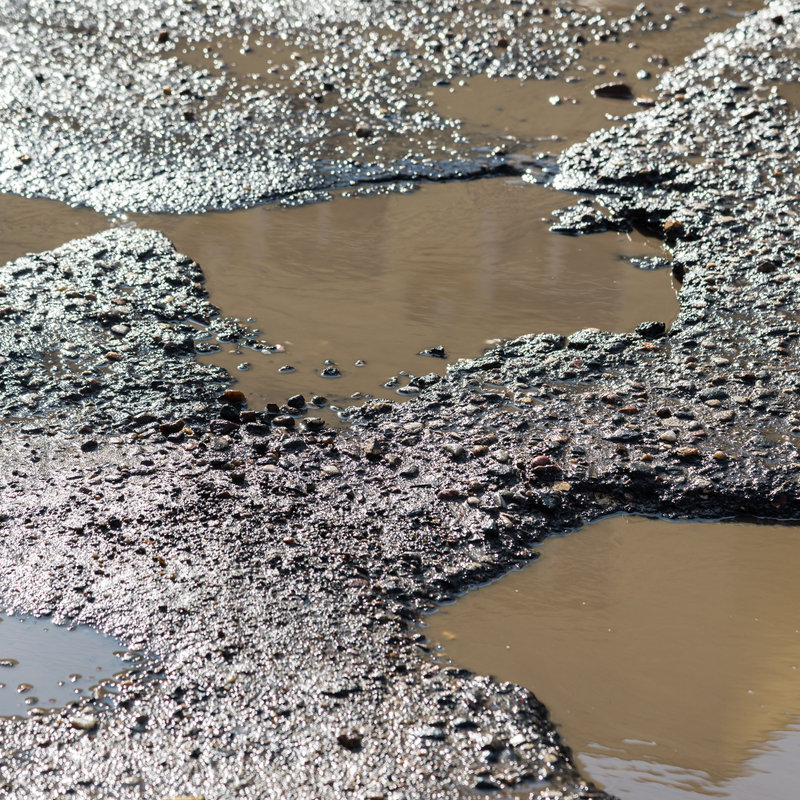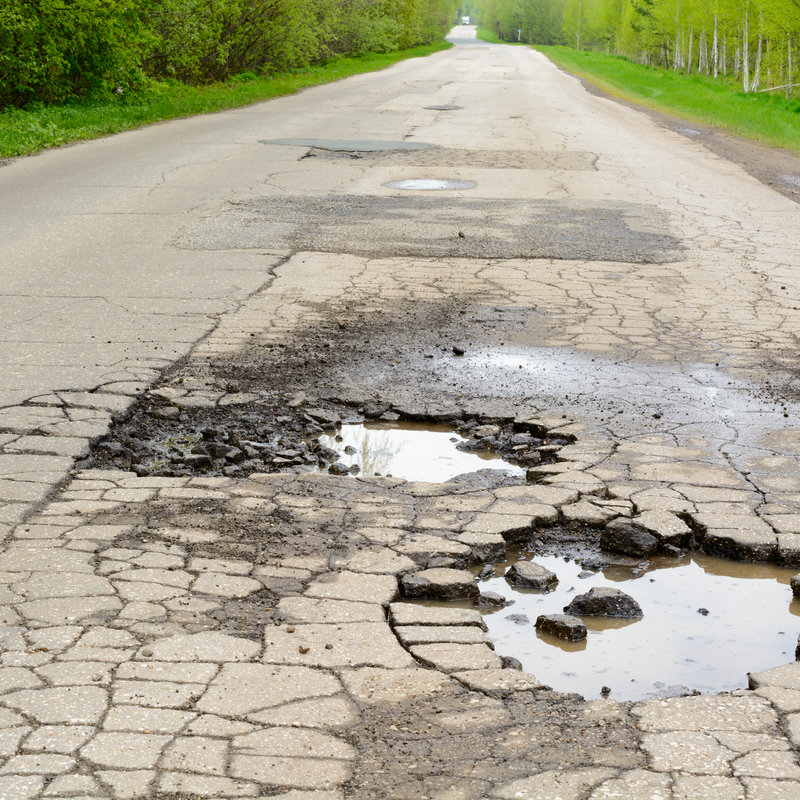
What is causing potholes?
If there is one thing that this country isn’t running out of is potholes. But we are behind on pothole repairs. No matter what city or state you live in today, there are potholes everywhere. From the parking lots to our personal driveways. What factors lead to potholes? Well, there is water, cars, hot and cold temperatures, and more water.
It seems that pothole repair is needed everywhere today. In every shape and size of the hole that the human mind can imagine. Nobody can argue with that! But is causing the potholes? Contraction and expansion of groundwater that has seeped underneath the surface. To be something we can’t live without, water can be evil too.
When it rains, the water will find its way to the lowest levels and into the smallest cracks. Then that water freezes which causes it to expand. Let’s look at how ice cubes form to visualize what that water is doing under the surface:
- Fill an ice tray with water and place it in the freezer. When you take the ice tray out later, that water has frozen and expanded. It is the same thing with water on the ground. It freezes on the surface and in the low areas where it ran off to and under the surface where seeped into even the smallest cracks.
- Now that frozen water under the surface has expanded, like the ice cubes in the freezer. This is taking up additional under the surface, causing the surface to expand. Since the surface isn’t meant to be flexible, as it expands, it breaks, cracks, and weakens with the gaps, and voids the ice created before it melted.
This process repeats itself over and over, then as cars start driving over that weakened surface, it causes it to break and crack more. The surface becomes displaced from the weight of traffic, and before long, you’re needing pothole repairs!
Why are potholes bad?
Potholes do not have smooth edges, so as you drive over them (or through them), at fast speeds, the wheels can be bent. And while good tires are made to take bumps, hitting a pothole damages the tires inside and knocks the front end of your car out of alignment. Hit a pothole hard enough and fast enough, it can break the shocks or struts on a car too, and thin, thread-bare, worn-out tires can be punctured.
What is the difference between a pothole vs sinkhole?
The difference between a pothole and a sinkhole starts with how they are formed. A pothole is a shallow depression or pit in a surface caused by the weather and the added weight of traffic. A sinkhole is formed by water running over rock, washing it away as it creates an underground passage
How can you prevent potholes?
Pothole repairs can be avoided by pothole prevention! There are preservation treatments that when used before a severe distress in the surface is formed. Such as sealing cracks in a pavement surface.
When having a driveway or parking lot installed, using a high-quality asphalt contractor will make a difference in minimizing pothole repairs too. In fact, that is the best pothole repair prevention is having the job done right from the beginning.
Once you notice cracks starting, even the smallest of cracks, have them sealed immediately. If you let the cracks go, you’ll be paying for pothole repair work soon. Yes, having asphalt cracks sealed is a cost, but it will stop the existing cracks from becoming potholes and it prevents new cracks too.
How long do pothole repairs last?
It can depend on the weather and the method used for the pothole repair. We just mentioned asphalt filling cracks, but that isn’t always the best process when it comes to pothole repairs. Here are the 3 common methods used today for pothole repairing:
- POTHOLE PATCHING: For a fast way for pothole repair, and it is also the shortest lifespan. The repair crew will shovel asphalt in the pothole, then compact the material using a tamper. The longest this type of pothole repair lasts is one year. While it may look like a completed pothole repair, the underlying problem is still there, so it will typically degrade quickly around and under the patch repair.
- MILL PATCHING: This is used on asphalt parking lots with surficial damage. The repair crew will mill a couple of inches off the surface around the pothole, then add compacted asphalt, creating a smooth surface. This will last longer than the above-described pothole patching method. However, it will still go through the freeze and thaw cycle, resulting in reflective cracking.
- DIG-OUT PATCHING: An expensive pothole repair method, which is why it isn’t more widely used. The process starts by removing an area of asphalt that is six-foot by six-foot around. And aggregate base is then added and re-graded. Then four inches of asphalt is added, and a roller is used to compact it down. Expensive but the longest-lasting method.
How long does it take to repair a pothole?
It can take between three and six days on average. The temperature and overall weather are the biggest factors when doing pothole repairs with asphalt. Other types of surfaces are handled differently, and the timeframe will vary. Here we are going to review the different types of pothole repairs that are done:
Concrete Driveway Pothole Repair:
Concrete is the most common type of driveway surface. Knowing how to repair a concrete driveway pothole yourself can save you some money and isn’t that difficult:
- For a concrete driveway that is spalling, experts recommend resurfacing with Quikrete Concrete Resurfacer available at home improvement stores. The dry mix powder-like mix comes in a bag that you mix with water and then spread over a section that needs repairing, spreading with a squeegee to fill in the spots.
- For a concrete driveway with a couple of ½ inch or smaller cracks, experts recommend using Quikrete Advanced Polymer Concrete Crack Sealant, also available at home improvement stores. It is dispensed using a standard caulking gun.
- Cracks that are bigger than ½ inch wide and deeper, you’ll need to fill with a foam pre-caulking rod. Push the foam rod into the crack and then use a concrete crack repair sealant.
Gravel Driveway Pothole Repair:
With routine maintenance, including pothole repairs, a gravel driveway will last for generations. Unless you own an excavator or want to fill the potholes with buckets of gravel, you’ll need to hire a contractor that knows how to repair a pothole in gravel driveways.
Asphalt Driveway Pothole Repair:
An asphalt driveway can be a beautiful finish to a landscaped home, but if a crack starts to form and isn’t sealed immediately, water will seep under the surface, destabilizing the gravel under the asphalt. This causes the asphalt to crumble, and then you have potholes. So, by knowing how to repair a pothole in an asphalt driveway, you can save your beautiful, blacktopped driveway!
- A couple of small cracks can be repaired using an asphalt sealant and a caulking gun. Simply fill the cracks with the sealant and the deterioration process is stopped.
- If you have several cracks in your asphalt driveway, use an asphalt repair tubing like Crack-Stix, available at home improvement stores. The pliable tubing is inserted into the cracks then heat it with a torch. The tar tubing will melt and fill the crack while sealing it too.
- A mop-on asphalt sealer can be the fix where there are a lot of tiny spider web cracks. Experts recommend Henry Driveway Filler and Sealer, available at big box retail stores. This asphalt resin doesn’t require heat either!

Closing Words
No matter what type of driveway or parking lot surface you have, staying on top of the smallest issues will keep the concern of pothole repairs to a minimum.
